
浏览器中cookies查看

Cookies can be useful when you’re in control of them. Today we’re taking a look at how you can control cookies by blocking them except for when you want them to enhance your user experience.
当您控制Cookie时,它们可能会很有用。 今天,我们将探讨如何通过阻止cookie来控制它们,除非您希望它们何时能改善用户体验。
我为什么要这样做? (Why Would I Want to Do This?)
A cookie is simply a small file that a web site places on your computer to store information. The process itself is totally benign, and can even be helpful—cookies do useful things like store your shopping cart information between sessions, save you from the hassle of logging into a site every time you open and close your browser, and other helpful time savers. The ones that give cookies a bad name track users without their explicit knowledge and help advertisers (or other entities) build profiles of users. Many people want to limit the amount of information that is gathered about them, and do so by limiting the kind of cookies that their browser accepts and retains.
Cookie只是网站在您的计算机上放置的一个小文件,用于存储信息。 该过程本身是完全良性的,甚至可能会有所帮助-Cookie会做一些有用的事情,例如在会话之间存储购物车信息,使您免于每次打开和关闭浏览器时都无需登录网站的麻烦以及其他有用的时间节省程序。 给Cookie起坏名的用户会跟踪用户而无需他们的明确知识,并帮助广告商(或其他实体)建立用户个人资料。 许多人想限制收集到的有关他们的信息量,并通过限制其浏览器接受和保留的Cookie的种类来做到这一点。
Today, we’re going to look at some quick ways to do this is Internet Explorer, Firefox, and Chrome using whitelists. It’s much easier to specify which sites you want to accept cookies from than it is to perpetually accept and decline the hundreds of cookies your browser is bombarded with.
今天,我们将探讨使用白名单的一些快速方法,例如Internet Explorer,Firefox和Chrome。 这是很容易来指定要接受Cookie从比它永远接受和拒绝数以百计的浏览器轰击饼干哪些网站。
This does come with a few downsides, however. You’ll stop getting custom tailored ads, and you’ll start experiencing intersitial ads more frequently (like pop-over ads and video lead-in ads), as these are frequency controlled by cookies. For example, we show a popup for our newsletter the first time any user visits our site—but use cookies to keep it from showing up every time. If you block cookies from our site, you’ll see that popup more often.
但是,这确实有一些缺点。 您将不再获得定制的量身定制的广告,并且将开始更频繁地体验插页广告(例如弹出式广告和视频导入广告),因为这些广告是由Cookie进行频率控制的。 例如,当任何用户第一次访问我们的网站时,我们都会为时事通讯显示一个弹出窗口-但要使用cookie来阻止每次显示。 如果您从我们的网站阻止cookie,则您会更频繁地看到该弹出窗口。
As such, this is a rather aggressive approach to controlling cookies. We recommend it if you’re really serious about keeping your privacy on lock down and controlling what third-parties can track about your online behavior, or as a really great exercise in seeing just how many times web sites attempt to load your computer down with cookies.
因此,这是一种控制Cookie的相当激进的方法。 如果您真的很想保护自己的隐私并控制哪些第三方可以跟踪您的在线行为,或者在查看网站尝试通过多少次网站尝试加载您的计算机时,将其作为一项非常好的练习,我们建议您使用此方法饼干。
在Internet Explorer中控制Cookie (Controlling Cookies in Internet Explorer)
Internet Explorer has simple but serviceable cookie controls. There are two main areas we’re interested in: managing site status and toggling the cookie acceptance. First let’s look at how to whitelist a site. Click on Tools [the gear icon in the corner on newer versions] > Internet Options > Privacy > Sites. Here you’ll find the Per Site Privacy Actions menu, which allows you to white or black list web sites.
Internet Explorer具有简单但可维护的cookie控件。 我们感兴趣的主要领域有两个:管理网站状态和切换Cookie接受度。 首先让我们看看如何将网站列入白名单。 单击工具[较新版本角落的齿轮图标]> Internet选项>隐私>网站。 在这里,您将找到“每站点隐私操作”菜单,该菜单使您可以将网站列入白名单或黑名单。
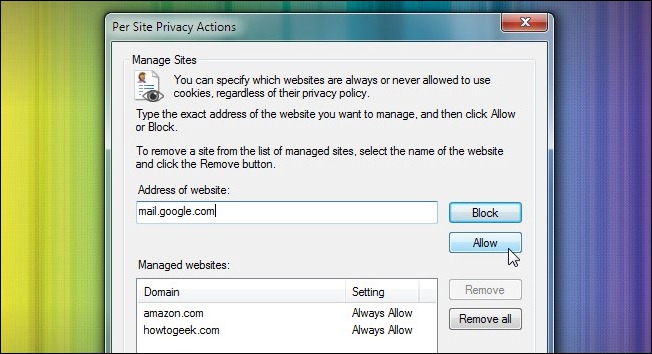
Manually entering every site you’d like to whitelist is a bit on the kludgy side, so we’re going to semi-automate the process by toggling the cookie settings. Visit Tools [gear icon] > Internet Options > Privacy, and under Settings, click Advanced.
手动输入您要列入白名单的每个站点有点麻烦,因此我们将通过切换Cookie设置来半自动化该过程。 访问工具[齿轮图标]> Internet选项>隐私,然后在设置下,单击高级。
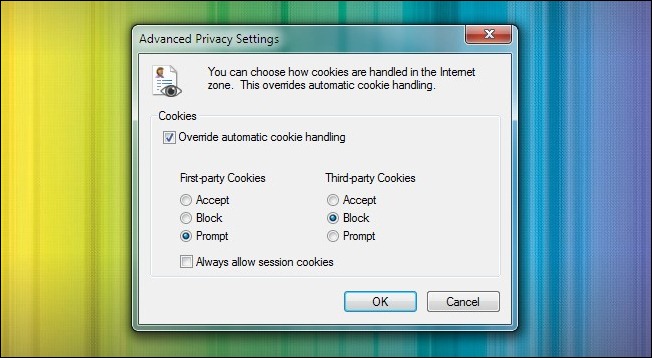
Here, you’ll find a simple radio-button based menu where you can toggle the settings for first-party and third-party cookies. We’re going to temporarily turn on first-party cookie prompting and block third-party cookies. Rather than try to remember every site you might want to add to your white list, this allows you to accept the cookies on a need-to-use basis as they appear. After a few days of browsing, you’ll have likely come across nearly every site you regularly use and will be able to add them to the white list on an as-needed basis. At that point, you can toggle it to Block or leave it on Prompt if you don’t find it to be a nuisance.
在这里,您会发现一个简单的基于单选按钮的菜单,您可以在其中切换第一方和第三方Cookie的设置。 我们将临时打开第一方Cookie提示并阻止第三方Cookie。 与其尝试记住您可能想添加到白名单中的每个站点,不如让它们在出现时按需要使用cookie。 经过几天的浏览,您可能会遇到几乎每个经常使用的网站,并且能够根据需要将它们添加到白名单中。 届时,您可以将其切换为“阻止”,或者如果您认为它不太麻烦,则将其保留在“提示”中。
Unfortunately in the realm of extensions, IE is a lightweight, and there aren’t any widely adopted cookie management extensions. If you’re a die-hard IE user and unwilling to switch to Firefox or Chrome, one available option is No More Cookies, which allows you to bulk authorize and delete cookies in your IE cache. Compared to the native functionality, it’s not a radical improvement, but it’s mildly useful.
不幸的是,在扩展领域,IE是轻量级的,并且没有任何被广泛采用的cookie管理扩展。 如果您是顽固的IE用户,并且不愿意切换到Firefox或Chrome,则可用的选项是No More Cookies ,它使您可以批量授权和删除IE缓存中的cookie。 与本机功能相比,这不是一个根本的改进,但它确实有用。
在Firefox中控制Cookie (Controlling Cookies in Firefox)
If you’re a Firefox user, you’ll find robust built-in controls. Open up Firefox and click on the main Menu button, then Options > Privacy. Once in the Privacy menu, click the first dropdown menu option under “History.” By default, this is set to “Remember History”—change it to “use custom settings for history.”
如果您是Firefox用户,则会发现强大的内置控件。 打开Firefox并单击主菜单按钮,然后单击选项>隐私。 进入“隐私”菜单后,单击“历史记录”下的第一个下拉菜单选项。 默认情况下,此设置为“记住历史记录”,将其更改为“对历史记录使用自定义设置”。
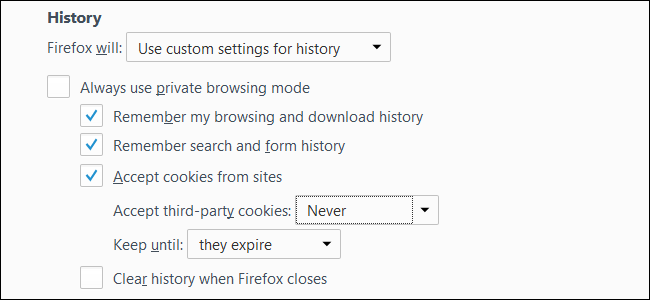
Under “Accept third-party cookies,” select “Never.” You can also change the first-party cookie setting de-selecting “Accept cookies from sites”. You can click the “Exceptions” button to manually add your most visited websites to the list, enabling them to store cookies for convenient logins and other settings. Just type the domain of the website and click “Allow” in this window to create the exception rule for the whitelist. You should be able to see which of your most visited sites really need cookie support after a week or two of regular browsing.
在“接受第三方Cookie”下,选择“从不”。 您还可以取消选择“接受来自站点的cookie”来更改第一方cookie设置。 您可以单击“例外”按钮,将访问量最大的网站手动添加到列表中,使它们可以存储cookie以便于登录和其他设置。 只需键入网站的域,然后在此窗口中单击“允许”即可为白名单创建例外规则。 经过一两个星期的常规浏览后,您应该能够看到哪些访问量最大的网站确实需要Cookie支持。
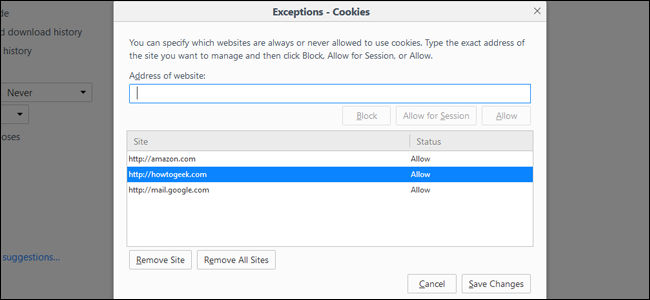
If you want to really dig in and get your hands dirty, you can examine cookies on a cookie-by-cookie basis by click on the Show Cookies button found on the Privacy tab. There, you can get detailed information about cookies and manually delete them.
如果您想真正深入研究并弄脏您的手,可以通过单击“显示Cookie”,逐个cookie地检查cookie。 在“隐私”标签上找到的按钮。 在这里,您可以获得有关cookie的详细信息并手动删除它们。
在Google Chrome中控制Cookie (Controlling Cookies in Google Chrome)
To access cookie controls in Chrome, click the main menu icon in the upper-right corner of the browser, choose “Settings” from the menu, then scroll to the bottom of the tab and click “Advanced.”
要在Chrome中访问Cookie控件,请单击浏览器右上角的主菜单图标,从菜单中选择“设置”,然后滚动到标签的底部并单击“高级”。
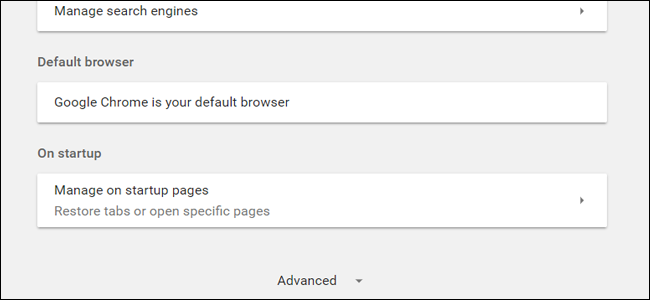
In the expanded list, click “Content Settings,” then “Cookies.”
在展开的列表中,单击“内容设置”,然后单击“ Cookies”。
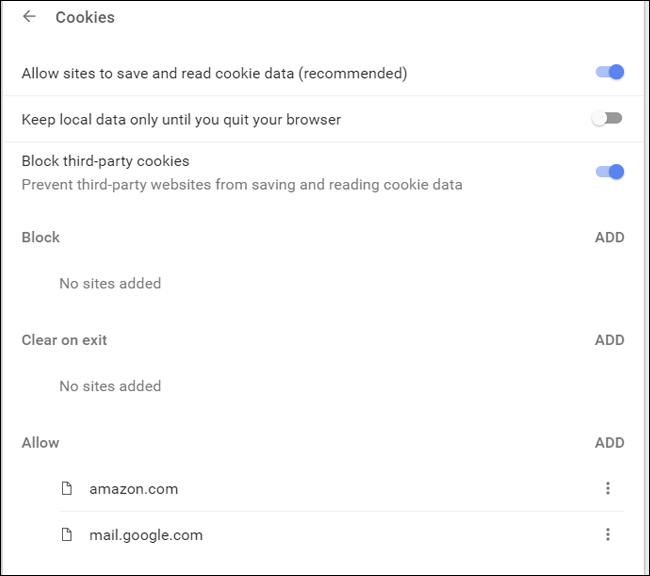
Like Firefox, this window has toggles for all cookies (“Allow sites to save and read cookie data”) and third-party cookies (“Block third-party cookies.”) Chrome applies both of these settings universally, then lets you add exceptions that will always be allowed and always be blocked.
与Firefox一样,此窗口具有所有cookie(“允许站点保存和读取cookie数据”)和第三方cookie(“阻止第三方cookie”的开关)。Chrome普遍应用这两个设置,然后让您添加例外这将始终被允许并且始终被阻止。
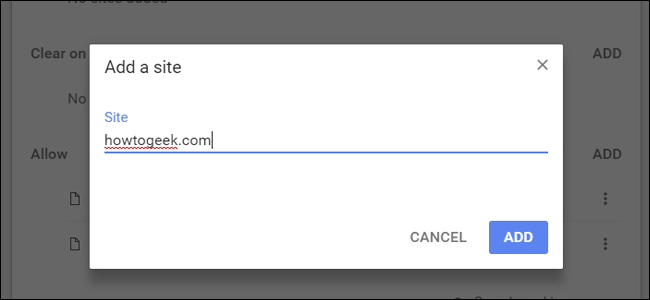
Click “Add” on the right of either option to add a new site to any of the lists. If you’ve changed your mind, you don’t have to manually add or remove them: click the three-dot menu on the left of individual sites to change them to “Block,” “Allow,” or “Clear on exit.”
单击任一选项右侧的“添加”以将新站点添加到任何列表中。 如果您改变了主意,则不必手动添加或删除它们:单击各个站点左侧的三点菜单,将其更改为“阻止”,“允许”或“退出时清除”。 ”
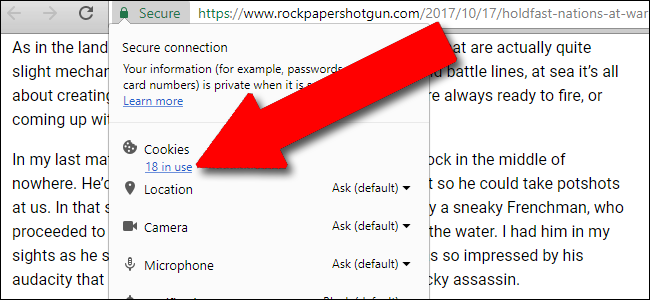
For easier cookie control on individual sites, click the favicon (the little site symbol to the left of the URL bar, replaced with “Secure” on an https domain), then click the number under “Cookies.”
为了更容易地控制单个站点上的cookie,请单击收藏夹图标(URL栏左侧的小站点符号,在https域上替换为“安全”),然后单击“ Cookies”下的数字。
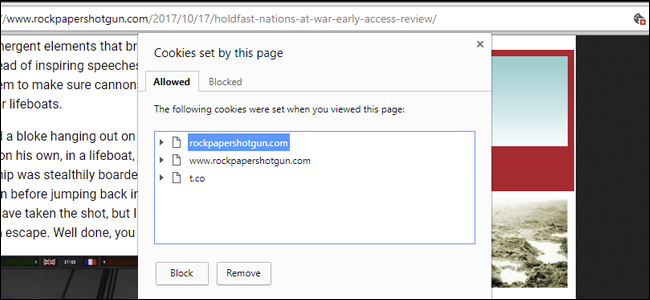
From this window you can set individual cookies or the entire site’s cookies to “Block” or “Allow.” This works best if you have all cookies blocked by default or third party cookies blocked, as otherwise the amount of tracking cookies on each page can overwhelm you in a huge list.
在此窗口中,您可以将单个Cookie或整个网站的Cookie设置为“阻止”或“允许”。 如果默认情况下所有Cookie都被阻止,或者第三方Cookie被阻止,则此方法效果最好,否则,每个页面上的跟踪Cookie数量可能会使您在庞大的列表中不知所措。
在Opera中控制Cookie (Controlling Cookies in Opera)
To get to the main settings menu in Opera, click the “O” button in the upper-left corner, then click “Settings.” Click “Privacy and security” and scroll down until you see the “Cookies” sub-section.
要进入Opera的主设置菜单,请单击左上角的“ O”按钮,然后单击“设置”。 点击“隐私和安全”并向下滚动,直到看到“ Cookies”小节。
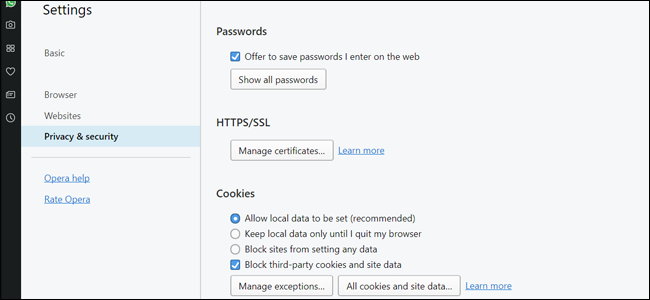
Here you have most of the same options from the browsers above: by default, the setting is “Allow local data to be set” (read: allow all cookies). For more security you can select “Block sites from setting any data” or more simply “Block third-party cookies and site data.”
在这里,您可以使用上述浏览器中的大多数选项:默认情况下,设置为“允许设置本地数据”(阅读:允许所有cookie)。 为了提高安全性,您可以选择“阻止网站设置任何数据”或更简单地选择“阻止第三方Cookie和网站数据”。
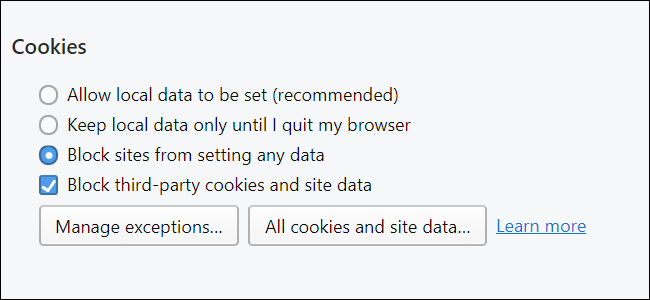
Exception controls open a new window that allows you to input individual sites to allow or disable cookies. Again, it should be pretty clear which of your commonly-visited sites need to be added to a white list after a week or two of browsing.
例外控件会打开一个新窗口,允许您输入单个站点以允许或禁用cookie。 同样,应该很清楚,一两个星期的浏览后,您需要将哪些常用网站添加到白名单中。
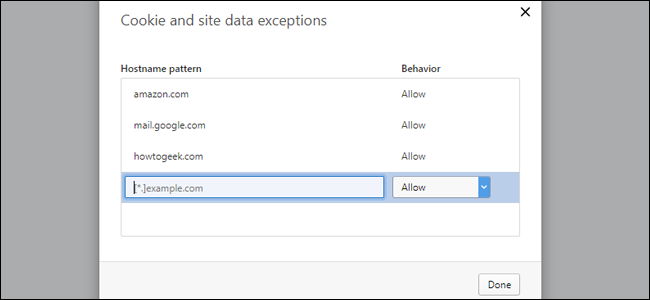
If you’d like per-site cookie controls in Opera without having to dive into the Settings menu, try using the Policy Control extension. This add-on will let you enable or disable more or less all settings, including per-site cookie tracking, by clicking a single button on the menu bar. The settings will be saved and applied based on the current domain.
如果您想在Opera中使用每个站点的cookie控件而不必深入到“设置”菜单,请尝试使用Policy Control扩展程序 。 此附加组件使您可以通过单击菜单栏上的单个按钮来启用或禁用或禁用或禁用所有设置,包括按站点cookie跟踪。 设置将根据当前域进行保存和应用。
在Microsoft Edge中控制Cookie (Controlling Cookies in Microsoft Edge)
To access cookie controls in Edge, click the three horizontal dot icon in the upper-right corner, then “Settings.” Scroll down to the bottom of the sidebar and click “”View Advanced Settings.”
要访问Edge中的cookie控件,请单击右上角的三个水平点图标,然后单击“设置”。 向下滚动到侧栏的底部,然后单击“查看高级设置”。
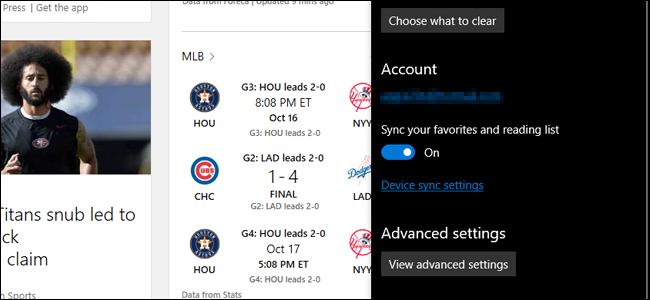
Scroll down to the bottom again, and look for the drop-down menu under “Cookies.” Click the option for “Block all cookies” or “Block only third party cookies” according to your preference.
再次向下滚动到底部,然后在“ Cookies”下查找下拉菜单。 根据您的喜好,单击“阻止所有cookie”或“仅阻止第三方cookie”选项。
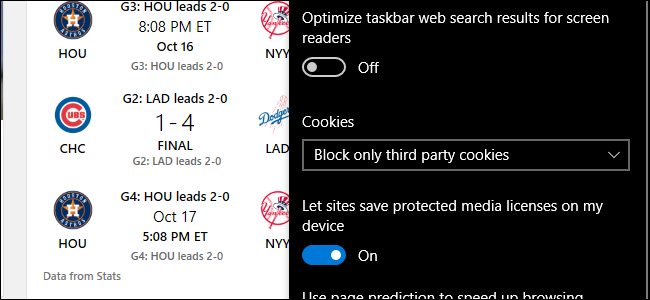
Unfortunately, Microsoft hasn’t enabled a whitelist or blacklist option for Edge yet, and none of the officially-supported extensions do, either. If you need more granular controls of your cookies, you should choose from one of the better-supported options above.
不幸的是,Microsoft尚未为Edge启用白名单或黑名单选项,并且官方支持的扩展都没有启用。 如果您需要对Cookie进行更精细的控制,则应从上面更好地支持的选项之一中进行选择。
翻译自: https://www.howtogeek.com/63721/how-to-block-all-cookies-except-for-sites-you-use/
浏览器中cookies查看





















 3506
3506











 被折叠的 条评论
为什么被折叠?
被折叠的 条评论
为什么被折叠?








